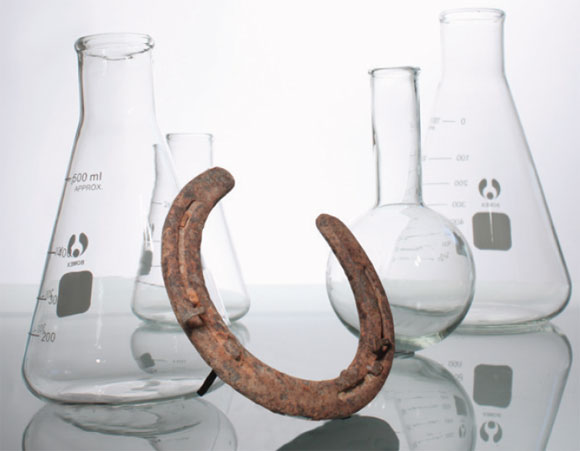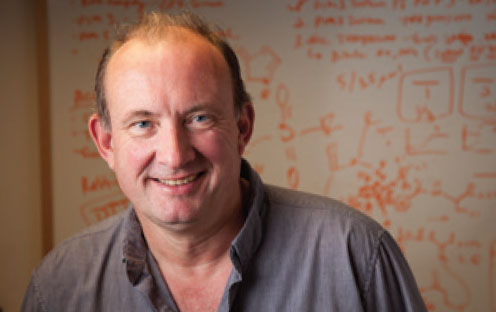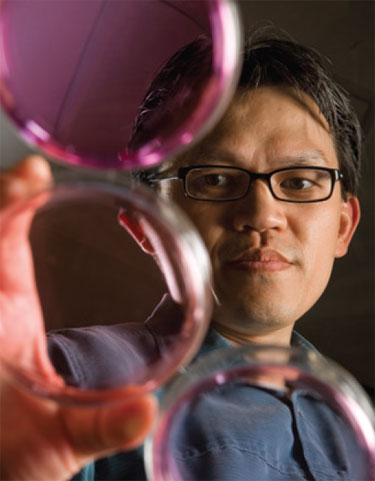
Most scientists can point to an instance when serendipity played a role in their work. Some of the most exciting scientific discoveries have happened by accident. Penicillin resulted from a spoiled bacteria culture. The radioactivity of uranium without outside light was discovered when a cloudy day derailed an experiment with sunlight.
Indeed, two scientists at Duke University School of Medicine feel their careers have been transformed by serendipity. One, a pharmacologist and cancer biologist, has found his way into an unexpected avenue of work that may lead to a new treatment for HIV. Another, a neuroscientist, is recognized as an innovator in understanding brain injury and repair, but he never planned to go into science in the first place.
Spinning The Roulette Wheel Of Drug Discovery
Drug discovery can involve conducting a massive screen in which millions of potential drugs are tested for their ability to bind to one target of interest -- a receptor or other structure in the body that is known to be associated with a particular disease. To Tim Haystead, PhD, associate professor of pharmacology and cancer biology, that method seemed like spinning a roulette wheel and hoping your number comes up. So he developed a new method that thoroughly interrogated one drug candidate at a time by screening it against all of an organ's vital cellular proteins at once.
He limited the group of proteins in the screen to only those likely to be involved in key processes in many of the body's cells. "We had this way of catching a very large piece of what we call the druggable proteome, which is all the proteins that use a certain type of nucleotide in cells called ATP," Haystead says. Proteins that bind to ATP often function as control switches for the most important functions inside a cell. "We could immobilize this ATP on a medium, and it would catch about 2,000 proteins at once," Haystead says. The scientists would isolate the vital proteins from specific tissues such as brain, liver, or testes. Then they used this medium to screen individual drug candidates against all these vital proteins at once. These screens provided a snapshot of all the diseases the drug could be useful in, as well as any possible side effects. "Drug discovery involves a lot of luck," Haystead says. "But the intellectual part was in trying to increase the probability that we would get a positive outcome. We tried to make luck work for us."
In 2000, Haystead (pictured below) founded a company to commercialize his drug discovery platform, and he named it Serenex, which can be translated as "out of serendipity."

After several years of exploration, Serenex began developing a handful of promising new drugs it had discovered using that platform. In 2008, the company was sold to pharmaceutical giant Pfizer, based largely on interest in one of those drugs, SNX5422. Serenex had found that the drug blocked an enzyme called HSP-90, which is used by many different oncogenes (genes that can turn normal cells into tumor cells). The drug is now in clinical trials as a potential treatment for several types of cancer, including lung, neuroendocrine, and blood cancers.
Though the company had closed up shop, the experience of launching it completely changed the focus of Haystead's work. "I literally dumped all the work I used to work on, which was focused on the whole process of muscle plasticity and signaling. After the company was bought, all I wanted to do was use this technology in an academic setting to explore new therapies that might not attract industry interest, but that are badly needed," he says. One example -- a therapy for HIV that wouldn't have to be taken daily, which would be more useful in developing countries than current therapies.
Back in his lab at Duke, Haystead began using his proteome-mining technology to find out how HIV infection affects all the body's vital proteins. While screening those 2,000 proteins for their activity in HIV, HSP-90, the same protein involved in cancer, came up again. The screens showed that HSP-90 is activated in immune system cells that are infected with HIV, but not in normal immune system cells.
That excited Haystead because it opened up the possibility that the same drug Serenex had developed to fight cancer might also have a lasting effect against HIV.
As Haystead explains, HIV isn't very robust on its own. In order to survive and keep making copies of itself, HIV hijacks immune system cells called CD4 cells. In early studies, the Serenex drug latches on to CD4 cells infected with HIV, and in some manner it prevents them from producing more virus. But it leaves normal CD4 cells intact. "One of the big hopes is that this drug could block the HIV life cycle," Haystead says. "If you can block that, you would control or possibly even clear the virus." Such a drug could save lives everywhere but would be especially beneficial in Africa, where taking expensive daily medications is not realistic for many people.
Haystead's HIV research is being conducted in the Duke Human Vaccine Institute (DHVI), in collaboration with Barton Haynes, MD, the Frederic M. Hanes Professor of Medicine and director of DHVI. "We hope Tim's HSP-90 inhibitors will attack HIV in novel ways and be able to add a powerful new approach to controlling or preventing HIV-1 infection," Haynes says. "Working with Tim is terrific because he brings both insightful creativity and lots of energy to all he does."
An Innovator Is Born

Chay T. Kuo, MD, PhD (right), the George W. Brumley Assistant Professor of Cell Biology, is a big believer in making room for luck in his science. Even his becoming a physician-scientist was a happy accident. After earning a bachelor's degree in architecture, Kuo was set to go to graduate school in that field. But his father, a neurosurgeon, insisted he apply to medical school. Kuo applied, assuming he would never get in. He did.
Once in medical school, Kuo found he liked answering scientific questions more than clinical ones, and during a neurology rotation he was struck by the fact that there were few if any good medical therapies to treat people who've had a stroke or traumatic brain injury. He has set about trying to change that. By exploring how and when stem cells help repair injury in the brain, he hopes to make discoveries that can lead to the development of drugs to enhance repair.
Most scientists who aim to manipulate stem cells in the lab to enhance brain repair try to coax the stem cells to produce new neurons. But neural stem cells alone in a culture dish won't make new neurons. Kuo has shown why, and he has also shown that making new neurons may not be the only key to repairing brain injury. He and his colleagues demonstrated this discovery in two significant publications -- one published in the journal Neuron in 2011 and featured on the cover, and another published in 2013 in the journal Nature. Both findings would probably never have been made, he says, were he not at Duke. "The questions remain the same, but if I were anywhere else, I could be working on something totally different," he says.
When Kuo first met with Brigid Hogan, PhD, chair of the Department of Cell Biology and George Barth Geller Professor for Research in Molecular Biology, to discuss joining the faculty at Duke, they talked about his interest in a region of the brain where stem cells make neurons. This region contains many ciliated cells that provide the stem cells with a supportive niche. Hogan suggested that he should take a look at a protein called Foxj1. Hogan had been studying Foxj1 in the lung for its ability to control production of ciliated cells, but its role in the brain was unknown. Then Kuo met another person who would provide him the inspiration he needed -- Vann Bennett, MD, PhD, a James B. Duke Professor and then vice chair of the Department of Cell Biology. Bennett studies a class of structural proteins called ankyrins; they would end up playing a big role in Kuo's subsequent findings. In 2011, Kuo and postdoctoral fellow Patricia Paez-Gonzalez, PhD, found that in order to produce new neurons, brain stem cells must be surrounded by a niche of supporting cells that he calls "the fountain of youth," and that Foxj1 must activate a particular type of ankryin to form that structure.
"Chay is an exceptionally creative and energetic young scientist," Hogan says. "He has succeeded by being open to ideas from different fields and applying them to an important clinical problem in neurobiology."
Later, Kuo and his team made a discovery that challenged the assumptions of the field to such an extent that peer reviewers for the journal Nature initially rejected it. He found that even in the "fountain of youth," stem cells don't always produce new neurons when the brain is injured; sometimes, they make cells called astrocytes. Astrocytes have generally been thought to be undesirable in this context because they can lead to scarring, and because they can undergo gene mutations that can lead to brain tumors.
But Kuo and former postdoctoral fellow Eric Benner, MD, PhD, now an assistant professor of pediatrics, showed that there is something special about the astrocytes that are produced by stem cells in response to injury. These astrocytes stop bleeding in the immediate aftermath of injury, directed by a molecule called Thrombospondin 4. In experiments in mice, when production of these astrocytes is blocked, the injured brain region doesn't heal. "Bleeding after brain injury is a serious and common problem for patients," Kuo says. He adds that he wouldn't have known where to look to find out what made these astrocytes different if he hadn't talked to Cagla Eroglu, PhD, assistant professor of cell biology, who works down the hall from him, and who intensively studies thrombospondins and other proteins secreted by astrocytes.
"If the belief is that neural stem cells inherently know what's best for the brain, then we suspect that making astrocytes instead of neurons for a time after injury is perhaps a good thing," Kuo says. "In most of our therapeutic efforts, when we're trying to suppress neural stem cells from making any other type of cells but neurons, maybe we're going down the wrong road. We have lots of other studies now building in this direction."
With both of these scientists, some of their discoveries could be chalked up to good fortune. Or maybe it's that they have a willingness to let luck in. Kuo, for instance, is not afraid to question scientific assumptions, and he sees connections that others may not.
"Maybe it helps that I'm not a particularly linear thinker," Kuo says. As Haystead likes to say, quoting Louis Pasteur: "Luck favors only the prepared mind."